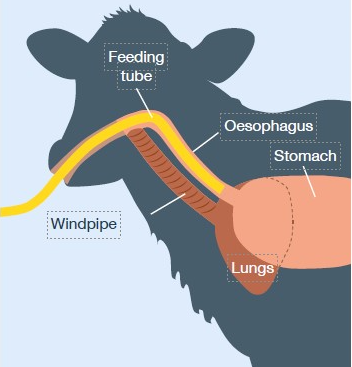Stomach tubing calves is the preferred option for many farmers when feeding calves colostrum shortly after birth.
A calves first feed of colostrum is the most important meal that they will receive in their entire life, but getting adequate amounts into calves can be a challenge.
Calves are born without immunity and obtain material antibodies from colostrum.
There are a number of ways that calves can receive colostrum. Firstly, they can suckle from the cow, but you can not be sure if the calf has gotten enough colostrum.
The two main options used by most dairy farmers are by a teat on a bottle, or by stomach tubing – both will ensure that a calf gets adequate amounts of colostrum.
Both methods are suitable for getting colostrum into calves, as research has shown that the level of immunoglobulins in the blood of calves fed using the two methods are equal.
Colostrum
Many would argue that the best method of feeding calves colostrum is through a teat feeder, or a bottle with a teat on it.
This is because teat feeding stimulates the natural reflex closure of the oesophageal groove, which means that the colostrum is deposited directly into the abomasum.
Fluid delivered by a tube feeder does not stimulate this reflex closure. As a result of this, fluid is deposited into the first three stomachs.
However, getting enough colostrum into calves using this method can be difficult, and ultimately both methods are effective at feeding calves colostrum.
During the busy spring calving period, stomach tubing is a slightly quicker way of getting the first feed into calves, and is likely going to be deployed on many farms.
Stomach tubing
Stomach tubing is an important skill that dairy farmers should be able to use when required.
When done correctly, it is a very effective way of getting colostrum into calves, but if done incorrectly, it could potentially injury the calf.
When tubing calves, there are some simple steps that can be followed:

- Before the tube is used, it should be inspected for damage. If the tube is damaged in any way it should not be used;
- Once the tube has been inspected for damage, it should be moistened/softened at the end with warm water;
- While standing, place the calf’s back into a corner, with one hand under the muzzle to keep the head and neck in a natural position;
- Slowly pass the tube over the tongue to the back of the mouth, ensuring the tube enters the oesophagus. You should be extremely careful to ensure the tube enters the oesophagus, and not the windpipe;
- When the tube is in the correct location, the calf should be comfortable and swallowing;
- Before you allow the colostrum to flow through the tube, the placement of the tube should be double checked. This can be checked by feeling the calves neck area. You should be able to feel the stomach tube – if not, the tube may be in the windpipe;
- Once you have ensured the tube is correctly placed, you can allow the colostrum to flow.
When feeding colostrum to a calf using a stomach tube, it is important that you take your time and remain calm.
It is also important that you have at least two stomach tubes, that are clearly marked. One should be used for colostrum and the other for sick calves.
Again, calves are born without any immunity, so feeding calves colostrum from a stomach tube that may have harmful bacteria on it is not advised.
